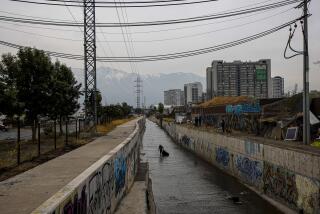Peruvian Squatters Draw a Line in the Sand, Build Homes on the Dunes
- Share via
LIMA, Peru — Maria Medina sits by her home perched on the side of a huge sand dune, looking out at the Pacific Ocean.
Her two children play by the doorway of the two-room shack made of straw matting and pressboard. The hillside has no yard and the children, ages 4 and 7, stay on the couple of feet of level sand around the house. Straying could mean tumbling down to the next shack and then to a gravel road.
“There’s no water, so I’m here waiting,” Medina says, watching for the water truck that passes by every few days to fill orange plastic barrels.
As precarious as the sand dune may be, it is just about the only place left for the Medinas and the 50 or so other families who have staked out plots on the drifting ridge about 15 miles south of downtown Lima.
The dune dwellers are playing out the last act of a drama that has been shaping and expanding Peru’s capital for nearly 40 years.
A flood of squatters, or “land invaders” as they are known in Peru, has swelled the city from a population of 1.8 million in 1960 to 6.5 million today.
Waves of migrants moved from the mountainous countryside seeking a better life in the 1960s and ‘70s or fleeing the political bloodshed of the 1980s. They settled in dusty shantytowns on the edge of town, and the outward march of the barrios has pushed Lima to its geographical limits.
“They went out beyond the green land to the sand dunes because that didn’t belong to anybody,” says the Rev. Thomas Burns, a Maryknoll priest who has worked in Lima’s barrios for 25 years.
Shantytowns are typical of cities that grow rapidly because of massive immigration, says Gustavo Riofrio, an urban planner working to improve housing in Lima.
“That’s how it was in the Old West in North America. That’s what the giant slums of the English cities in the last century were. We find the same thing in all Latin American cities,” he says.
Successive governments did little to build low-income housing, and instead allowed, even encouraged, squatting on public land in the desert outside Lima.
Today these pueblos jovenes--Spanish for “young towns”--are home to nearly 40% of Lima’s population, forming a ragged semicircle around the coastal city.
With the last usable scraps of land being taken over by squatters, Lima’s future is now upward, Riofrio says. All across Lima’s shantytowns, reinforcing rods sprout from flat cement roofs. The rods will become two- and three-story additions--the next generation of housing.
On the sand dune where Medina has lived for a year, the constantly shifting grains roll downhill and threaten to undermine her flimsy walls. She and her husband regularly haul accumulated sand from behind their home to shore up the front. Their neighbors do the same.
“You have to walk like a crab,” says Edith Zembrano, 30, a single mother who lives with her 4 1/2-year-old son higher up the dune. “You walk and you walk and then go backwards because you slip.”
A dirty yellow shag carpet covers part of the Medinas’ bedroom to keep the children off the packed sand floor. The family of four shares one double bed.
An extension cord stretching over the top of the dune powers a few lamps and a small black and white television. A kerosene burner serves as a stove; the kitchen has straw matting for walls and blue plastic sheets for a roof. The toilet is a pit in the sand, the bath a bucket and a sponge.
The conditions may be harsh, but for Medina it is a start, a chance for her own home.
City officials have told the squatters on the dune that they will never be able to build more than one-story homes of lightweight material to avoid collapsing the sandy escarpment.
“Whatever it is, as long as it’s a house,” Medina says.
More to Read
Sign up for Essential California
The most important California stories and recommendations in your inbox every morning.
You may occasionally receive promotional content from the Los Angeles Times.










